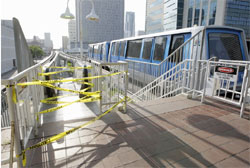| Home | Blog | Ask This | Showcase | Commentary | Comments | About Us | Contributors | Contact Us |

Taken for a ride in MiamiSHOWCASE | July 185, 2008Reporter Larry Lebowitz gives the backstory for what resulted in a rich Miami Herald multi-media series on big promises to improve mass transit, but little action. By Larry Lebowitz MIAMI—I started work on “Taken For a Ride”, a three-day series that ran recently in the Miami Herald, with two simple follow-the-money questions: What were Miami-Dade County taxpayers promised when they finally ratified a half-percent sales tax to improve mass transit in 2002, and what did they get? The results weren't pretty. The campaign promised "New Money for New Projects' but more than 60 percent of the funds went into routine Miami-Dade Transit operations. Right after the vote, county managers and transit administrators made a few moves that assured that more than $700 million would eventually be allocated to fix old, long-standing problems – the legacy of years of inadequate funding, no fare increases, and putting off expensive maintenance, modernization and upkeep tasks. The 2002 People's Transportation Plan campaign, led by a popular former mayor who once harbored national ambitions, way overstated what it could accomplish. It was wrong in stating how many projects it could afford. It ignored the condition of the existing transit system that was on the verge of financial, and in some cases, physical collapse. And despite promises, it never did protect the public's interests with an independent trust that was supposed to oversee all of the spending and project prioritization. The government has spent much of the money but failed to provide most of the new services promised; it has become the "bait-and-switch' that many opponents had feared. That lack of leadership, and the unwillingness to honestly address the problem, has allowed hundreds of millions of dollars to be spent on tiny projects in municipalities and commissioners' districts that have done little to improve the transit system or relieve traffic congestion – another cornerstone of the 2002 campaign. Now, nearly six years later, the current county leadership is struggling to not only acknowledge the depth and breadth of the problem, but figure out politically palatable ways to fix it. Gas prices officially hit $4 a gallon the same day that the project started. The crush for smart, efficient mass transit has never been greater, especially in newer Sun Belt metropolitan areas like South Florida that came of age with the rise of the automobile, cheap gasoline and sprawling suburban tract housing. Reaction to the series has been strong. There has been lots of follow-up coverage on local radio and television. One county commissioner's plan to actually raise another half-cent sales tax went down in flames days after the story ran. Commissioners aren't even willing to raise fares as more routes are being cut back. A group of civic leaders is organizing a campaign that would ask voters to repeal the tax if the government doesn't quickly get its act in order. The Herald is considering sponsoring a Town Hall-style meeting to discuss what happened to the tax and how to improve mass transit in the region. And I still have follow up stories to land. The stories are part of a sophisticated multi-media approach, including video, slide show and interactive maps. One person who deserves much credit is the photographer, John Van Beekum, for giving a real feel in pictures of what transit in Miami is like. Click here for an overview of the series; here for Part 1 and the accompanying items; here for Part 2, and here for Part 3.
|




